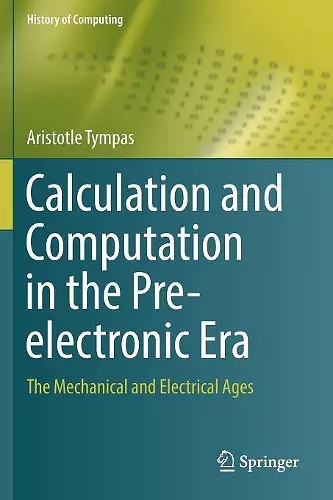Calculation and Computation in the Pre-electronic Era
The Mechanical and Electrical Ages
Format:Paperback
Publisher:Springer London Ltd
Published:24th Apr '19
Currently unavailable, and unfortunately no date known when it will be back

Although it is popularly assumed that the history of computing before the second half of the 20th century was unimportant, in fact the Industrial Revolution was made possible and even sustained by a parallel revolution in computing technology. An examination and historiographical assessment of key developments helps to show how the era of modern electronic computing proceeded from a continual computing revolution that had arisen during the mechanical and the electrical ages.
This unique volume introduces the history of computing during the “first” (steam) and “second” (electricity) segments of the Industrial Revolution, revealing how this history was pivotal to the emergence of electronic computing and what many historians see as signifying a shift to a post-industrial society. It delves into critical developments before the electronic era, focusing on those of the mechanical era (from the emergence of the steam engine to that of the electric power network) and the electrical era (from the emergence of the electric power network to that of electronic computing). In so doing, it provides due attention to the demarcations between—and associated classifications of—artifacts for calculation during these respective eras. In turn, it emphasizes the history of comparisons between these artifacts.Topics and Features:
- motivates exposition through a firm historiographical argument of important developments
- explores the history of the slide rule and its use in the context of electrification
- examines the roles of analyzers, graphs, and a whole range of computing artifacts hitherto placed under the allegedly inferior class of analog computers
- shows how the analog and the digital are really inseparable, with perceptions thereof depending on either a full or a restricted view of the computing process
- investigates socially situated comparisons of computing history, including the effects of a political economy of computing (one that takes into account cost and ownership of computing artifacts)
- assesses concealment of analog-machine labor through encasement (“black-boxing”)
“Tympas (National and Kapodistrian Univ. of Athens, Greece) traces the story of analog computing devices in the preelectronic (or pre-digital) era, from the mid-19th century to the mid-20th century. … Tympas's meticulous attention to detail is demonstrated by the extensive references provided at the end of each chapter. All the references are united in a cumulative reference section at the end of the book. There is also a well-constructed, useful index. … Recommended. Upper-division undergraduates and above.” (J. Beidler, Choice, Vol. 56 (1), September, 2018)
ISBN: 9781447174103
Dimensions: unknown
Weight: 454g
243 pages
Softcover reprint of the original 1st ed. 2017